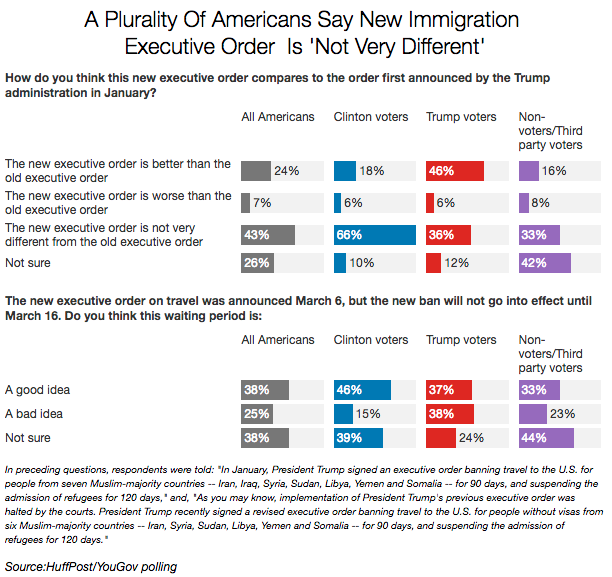President Donald Trump’s revised executive order on immigration strikes a plurality of the public as being largely the same as his initial order, a new HuffPost/YouGov survey finds.
The new order, which Trump signed Monday, drops Iraq from the list of Muslim-majority countries affected and makes exceptions for U.S. permanent residents and those with valid visas to enter the country but still includes some elements of the previous order.
Forty-three percent of Americans say the order is not very different from the old executive order, while 24 percent say it’s better and 7 percent that it’s worse.
Trump voters, who overwhelmingly backed the plan to begin with, are the most likely to consider it an improvement, with 46 percent saying the new order is better and 36 percent that it’s not much different. In contrast, two-thirds of Hillary Clinton voters see the new order as largely unchanged from the previous version, with just 18 percent considering it an improvement.
The new executive order won’t go into effect until March 16, a delay that Americans, by a 13-point margin, see as a good idea. Clinton voters are about three times likelier to say the waiting period is a good idea than a bad idea, while Trump voters are about evenly divided.

Despite the sentiment that not much has changed, Americans rate the new order more favorably. Opinions on the original travel ban are close to split, with 44 percent approving and 46 percent disapproving. In contrast, 47 percent say they approve of the revised ban, with 40 percent disapproving. (For a variety of reasons, polling on the executive order has varied widely across surveys, with the majority indicating it to be unpopular to some degree. HuffPost/YouGov’s poll on the initial ban was among the surveys finding the lowest levels of opposition.)
Just a third of Americans now say the government has done a somewhat or very good job of carrying out the ban, down from 41 percent in a poll taken just after the initial order was rolled out in February, but up modestly from the 27 percent who said so after a court halted that ban’s implementation.
A majority of the public, 53 percent, say they believe the travel ban is intended to target Muslims, with just 28 percent saying they don’t think that is the aim. Americans are split on how it affects the nation’s safety, with 34 percent saying it makes the U.S. safer, 20 percent that it makes the U.S. less safe, and 31 percent that it does neither.
Explore the results of HuffPost/YouGov’s survey with the widget below, using the menu at the top to select survey questions and the buttons at the bottom to filter the data by subgroups:
The HuffPost/YouGov poll consisted of 1,000 completed interviews conducted March 7-8 among U.S. adults, using a sample selected from YouGov’s opt-in online panel to match the demographics and other characteristics of the adult U.S. population.
The Huffington Post has teamed up with YouGov to conduct daily opinion polls. You can learn more about this project and take part in YouGov’s nationally representative opinion polling. Data from all HuffPost/YouGov polls can be found here. More details on the polls’ methodology are available here.
Most surveys report a margin of error that represents some, but not all, potential survey errors. YouGov’s reports include a model-based margin of error, which rests on a specific set of statistical assumptions about the selected sample, rather than the standard methodology for random probability sampling. If these assumptions are wrong, the model-based margin of error may also be inaccurate. Click here for a more detailed explanation of the model-based margin of error.

